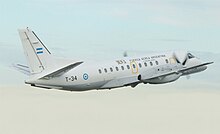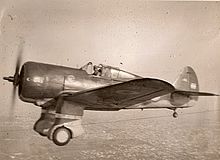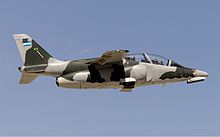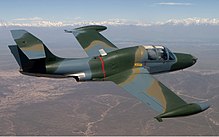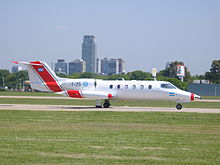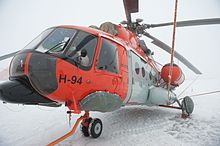
This article describes the composition and actions of the Argentine air forces in the Falklands War, which comprised units of the Air Force, Army, Navy and other services.
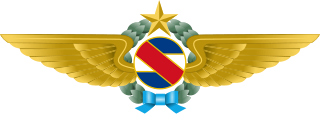
The Uruguayan Air Force is the air service branch of the Armed Forces of Uruguay. Originally created as part of the National Army of Uruguay, the Air Force was established as a separate branch on December 4, 1953. It is the youngest and also the smallest branch of the Armed Forces of Uruguay. In 1977 it was determined that the mission of the Air Force is to conduct strategic and tactical aerospace operations on behalf of the national defense, exercising the sovereignty of the Uruguayan airspace and defending the independence, integrity, constitution and laws of the country. The Air Force must also conduct search and rescue missions and plan, propose, execute and supervise the necessary measures for the development of the aerospace potential, while providing any necessary and possible logistical support during the natural disasters that the country may suffer. Since 1985 this has been always carried out under the command of the President of Uruguay, and according to the Minister of National Defense.

The Argentine Air Force is the air force of Argentina and one of three branches of the Armed Forces of the Argentine Republic. In 2018, it had 13,837 military and 6,900 civilian personnel. FAA commander in chief is Brigadier Major Fernando Mengo.

The Mexican Air Force is the air service branch of the Mexican Armed Forces. It is a component of the Mexican Army and as such overseen by the National Defense Secretariat (SEDENA). The objective of the FAM is to defend the integrity, independence, and sovereignty of Mexico. Its auxiliary tasks include internal security, assisting with public works, and natural disaster management. As of 2023, its commander is Bertín Hernández Mercado.
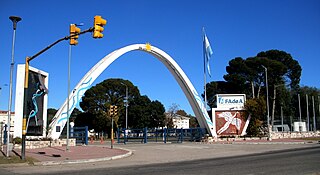
The Fábrica Argentina de Aviones SA, is Argentina's main aircraft manufacturer. Founded on 10 October 1927 and located in Córdoba, for most of its existence it was known as "Fábrica Militar de Aviones" (FMA), until its privatization in the 1990s to Lockheed Martin. In 2009 the concession ended and the company is now wholly owned by the Argentine government.

The Guatemalan Air Force is the aerial warfare service branch of the Armed Forces of Guatemala. The FAG is a subordinate to the Guatemalan Military and its commanding officer reports to the Defence Minister.

The Chilean Air Force (Spanish: Fuerza Aérea de Chile is the air force of Chile and branch of the Chilean military.

The Colombian Air Force is the aerospace force of the Republic of Colombia. The Colombian Air Force is one of the three institutions of the Military Forces of Colombia charged, according to the 1991 Constitution, with working to exercise and maintain control of Colombia's air and to defend its sovereignty, territorial integrity and constitutional order. It is one of the largest air forces in the Americas and has increased its activity due to important roles in the fight against narco-terrorism. Its main force includes 21 IAI Kfirs as defense fighters and 12 Cessna A-37 Dragonfly plus 24 Embraer 314 Super Tucano for counterinsurgency.

The Ecuadorian Air Force is the air branch of the Armed Forces of Ecuador.
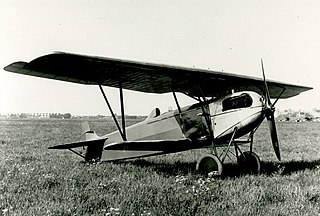
The Fokker D.XI was a 1920s Dutch single-seat fighter designed and built by Fokker

The Air Force of the Dominican Republic, is one of the three branches of the Armed Forces of the Dominican Republic, together with the Army and the Navy.
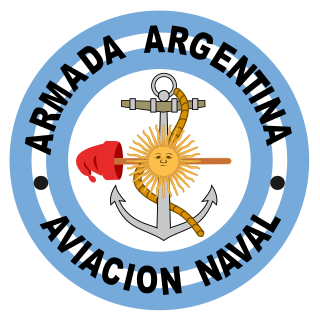
The Argentine Naval Aviation is the naval aviation branch of the Argentine Navy and one of its four operational commands. Argentina, along with Brazil is one of two South American countries to have operated two aircraft carriers.

The Argentine Army Aviation is the army aviation branch of the Argentine Army. Their members have the same rank insignia and titles as the rest of the Army. The Army Aviation Command is based at the Campo de Mayo Military Airfield.

The Paraguayan Air Force is a branch of the Armed Forces of Paraguay, in charge of the defense of Paraguay's skies. Its interim commander is Air Division General Julio Rubén Fullaondo Céspedes. Its headquarters are located in Ñu Guazu, Luque, a city which belongs to Gran Asunción.

The National Aeronautics Museum "Brigadier Edmundo Civati Bernasconi" is an Argentine museum located in the city of Morón, Buenos Aires. Established in 1960, the museum is dedicated to the history of aviation, in particular the Argentine Air Force.


